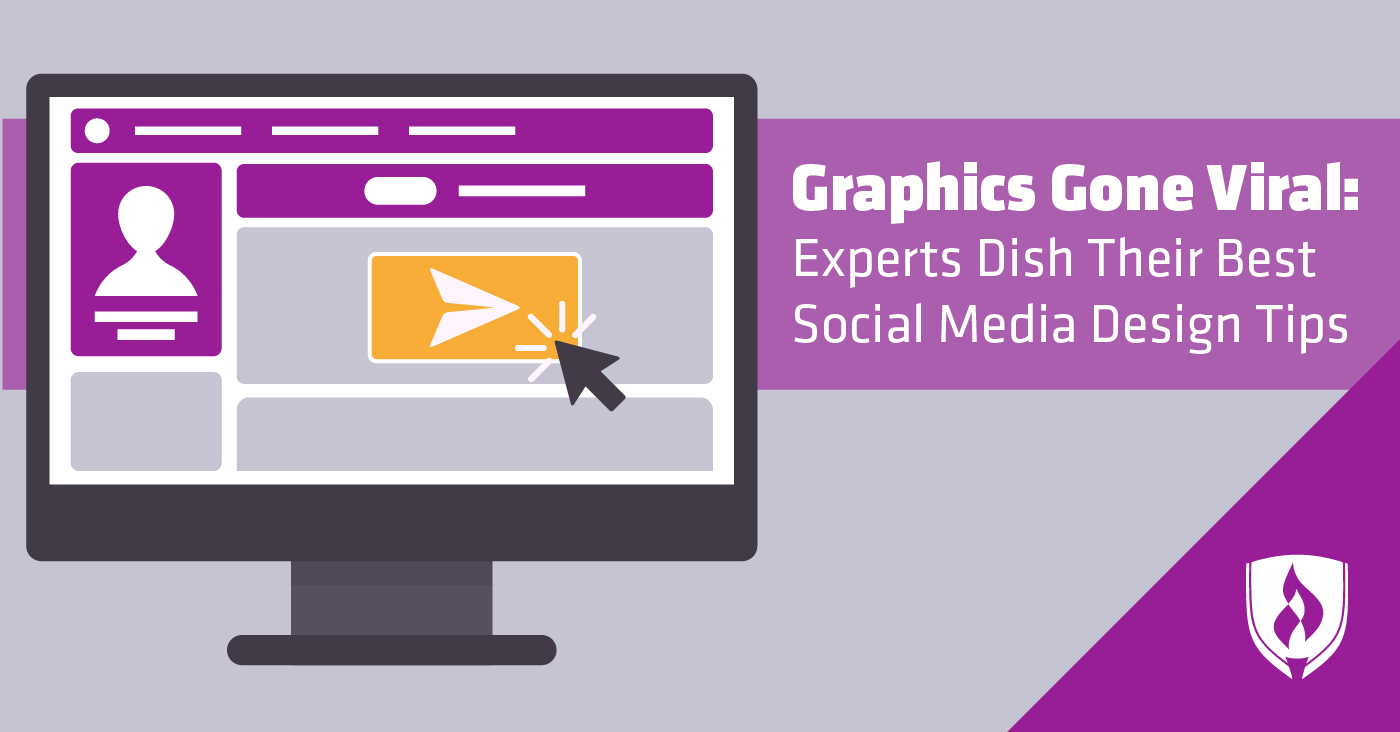Graphics Gone Viral: Experts Dish Their Best Social Media Design Tips
By Anjali Stenquist on 10/07/2019

Social media websites and apps like Facebook®, Twitter®, and Snapchat® allow brands to reach more potential customers than ever before—in fact one study reports 3.48 billion people used social media in 2019 alone.1
Marketing and advertising agencies are looking for social media savvy designers who can create visual messages specially made for social media platforms. While that’s great for aspiring graphic designers to hear, designing for the social media audience comes with unique challenges and opportunities as well.
“Consumption of visual material happens in less than 2 seconds,” says Sarah Moore, director of marketing and brand at Productive Outcomes. “Your design must connect on an emotional level using mostly imagery to tell the story of the brands you are working for and also connect with their customer base on an emotional level.”
In the fast-scrolling world of social media, it is essential that graphic designers understand compelling visual storytelling in order to promote a clear, memorable message.
Social media design tips from seasoned designers
These six tips from graphic designers in social media marketing are key tools for creating highly clickable designs.
1. Know your audience
Social media is all about connection—whether that’s with your best friend from first grade, or with communities of eco-conscious consumers, the “social” of social media is front and center. Creating a relationship between the brand and social media users depends on understanding your audience.
Anjana Wickramaratne, CEO of Ispirenix, begins by identifying a client’s audience based on relatively simple factors like age and gender. “These factors react to different types of posts and designs. For example, youth audiences like to engage with more colorful and trendy posts, while the elderly like to engage with plain colored and calming posts,” Wickramaratne explains. “A designer must know how to identify the audience of the social media profiles they are designing for and adapt.”
While detailed profiles of a target audience might not always be available, do what you can to gather as much information as possible before starting a design—even using a client’s best guess as a starting point can help.
2. Create a cohesive look
In order to maintain the connection with a unique audience, a brand’s social media graphics need to be consistent.
“The individual concept per post is important,” Jillian Rhein, creative services manager for Tandem Interactive, says. “But you have to think about how they interact with each other and the overall messaging you are delivering to audiences.”
Like a chess player, the savvy graphic designer should be thinking about the big picture and how each individual piece fits into an overall campaign. “Creating a strategy ahead of time—color palette, types of imagery, templates, etc.—will help while you design content,” Rhein says. A single social media post is only part of a bigger story a designer is telling about a brand’s mission, values and personality.
3. Be aware of your platform
The term “social media marketing” describes working with a number of very specific platforms. “As a graphic designer you should know the aspect ratio for all platforms and customize for each,” says Sarah Moore. “Not treating each platform as its own design is lazy design. It is not a one size fits all solution because people look to each platform differently.”
A graphic designed for image-centric Pinterest® might not appeal to users on Twitter. Even people who use both media platforms have different expectations and uses for each site. Effective graphic designers think through how users interact with specific social media sites.
“No longer does the ‘one and done’ approach work,” agrees Alexa Westerfield, creative director and social media strategist at Ppl Studio and Swell Creative Media. “You have to design a horizontal, vertical and square option as well as consider the nuances of each platform. It takes a deeper understanding of best practices for various social media channels.”
4. Don’t design in a vacuum
Graphic design doesn’t have to be done alone—in fact, it probably shouldn’t! Use the people and designs around you for inspiration, feedback, and collaboration. Even more than traditional media, social media marketing is designed to be shared and can go viral for good (or even bad) reasons. Getting feedback from a diverse group of people can help fill in your blind spots. It’s important to understand how your design will be understood within a larger context.
“Do research. See what your competitors are doing,” says Matt Benevento, design team lead at Geek Powered Studios. “Figure out what’s working for them and what isn’t. Don’t copy them—just see what you can learn from them.”
Additionally, Benevento recommends always having others review your work.
“What you might think is funny might be offensive to everyone else. It’s not true that all press is good press,” he says. If nothing else, an extra set of eyes on your work will help with Benevento’s biggest piece of advice—spell check your work.
5. Know your endgame
“So I clicked on your post, now what?” asks Benevento. You’ve been hired to create content for a brand on social media for a specific purpose. It’s easy to lose sight of the forest through the trees when creating posts for social media. What makes a successful graphic designer stand out is a constant awareness of the bigger mission of a social media post.
“What do you expect your audience to do after seeing the post? Is it just brand awareness or are you selling something? Be aware of what happens after they interact with your post,” Benevento explains. “Will they be directed to a landing page? Does the messaging match? Is the offer you just gave them present on that page? It may seem like obvious advice but you would be surprised at how many people don’t consider the user journey after the post.”
6. Connect, connect, connect
“In order to reach your target audience you must emotionally connect to them, no matter what the product or service is,” Moore says.
Moore goes on to explain that part of the reason she purchases name-brand shampoo over cheaper alternatives is because they convey that they care about the same things she cares about.
“When you speak to their heart and connect emotionally brand loyalty is born. Graphic design is responsible for that as much as marketing is.”
As a graphic designer working on social media, you have a unique opportunity to foster ideas and communities. Identify what connects people to your brand or organization, and design content that speaks to those shared ideals.
By designing using a style you know will appeal to your audience, building a unified design profile, considering your platform, consulting those around you and knowing what you hope users will do with the post you create, you have the potential to create truly viral graphic design.
Learn more about graphic design and marketing
Now that you’re equipped with these social media design tips, you might be surprised how closely intertwined the work of a graphic designer is with marketing professionals. It’s not always an easy space to navigate when you’re just starting out—but you’re in luck! Our article, “Graphic Design and Marketing: 6 Things Designers Wish They Knew Before Starting Out” gives you a chance to learn from the experience of other designers.
1We Are Social & Hootsuite, Global Digital 2019, [accessed September, 2019] https://wearesocial.com/global-digital-report-2019.




